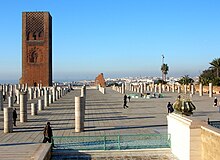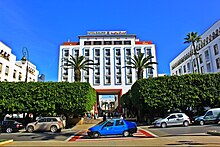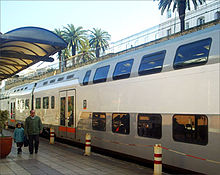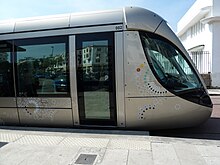| Revision as of 10:12, 17 November 2013 edit41.249.18.49 (talk)No edit summary← Previous edit | Revision as of 10:12, 17 November 2013 edit undoSluzzelin (talk | contribs)Extended confirmed users, Pending changes reviewers, Rollbackers34,744 editsm Reverted edits by 41.249.18.49 (talk) to last version by Kiril SimeonovskiNext edit → | ||
| Line 1: | Line 1: | ||
| {{Other uses|Rabat (disambiguation)}} | {{Other uses|Rabat (disambiguation)}} | ||
| {{Infobox settlement | {{Infobox settlement | ||
| |official_name = |
|official_name = Rabat | ||
| |other_name = | |other_name = | ||
| |native_name = Errbaṭ | |native_name = Errbaṭ ⴻⵔⵔⴱⴰⵟ الرباط | ||
| |nickname = | |nickname = | ||
| |motto = | |motto = | ||
Revision as of 10:12, 17 November 2013
For other uses, see Rabat (disambiguation). Place in Rabat-Salé-Zemmour-Zaer, Morocco| Rabat Errbaṭ ⴻⵔⵔⴱⴰⵟ الرباط | |
|---|---|
| Clockwise from top left:Kasbah of the Udayas, Mohammad V Avenue, Hassan Tower, Moroccan Parliament Building, Night in Bou Regreg Marina, View of Kasbah of the Udayas from Bou Regreg, Enblem of RabatClockwise from top left:Kasbah of the Udayas, Mohammad V Avenue, Hassan Tower, Moroccan Parliament Building, Night in Bou Regreg Marina, View of Kasbah of the Udayas from Bou Regreg, Enblem of Rabat | |
 FlagOfficial seal of RabatSeal FlagOfficial seal of RabatSeal | |
| Country | |
| Region | Rabat-Salé-Zemmour-Zaer |
| Founded by Almohads | 1146 |
| Government | |
| • Mayor | Fathallah Oualalou |
| Area | |
| • City | 117 km (45.17 sq mi) |
| Elevation | 75 m (246 ft) |
| Highest elevation | 135 m (443 ft) |
| Lowest elevation | 0 m (0 ft) |
| Population | |
| • City | 620,996 |
| • Density | 5,300/km (14,000/sq mi) |
| • Metro | 2,120,192 |
| • Population Rank in Morocco | 6th |
| Website | http://www.rabat.ma/ |
Rabat (Arabic: الرباط, ar-Ribaaṭ, literally "Fortified Place"; Berber: ⴻⵔⵔⴱⴰⵟ, Errbaṭ; Moroccan Arabic: ارّباط, Errbaṭ) is the capital and second largest city of Morocco with an urban population of approximately 620,000 (2004) and a metropolitan population of over 1.2 million. It is also the capital of the Rabat-Salé-Zemmour-Zaer administrative region.
The city is located on the Atlantic Ocean at the mouth of the river Bou Regreg. On the facing shore of the river lies Salé, the city's main commuter town. Rabat, Temara, and Salé form together a conurbation of over 1.8 million people. Silt-related problems have diminished Rabat's role as a port; however, Rabat and Salé still maintain important textile, food processing and construction industries. In addition, tourism and the presence of all foreign embassies in Morocco serve to make Rabat one of the most important cities in the country.
Rabat is accessible by train through the ONCF system and by plane through the nearby Rabat-Salé Airport.
The Moroccan capital was recently awarded second place in "Top Travel Destinations of 2013" by CNN.
UNESCO World Heritage Site| UNESCO World Heritage Site | |
|---|---|
 | |
| Criteria | Cultural: ii, iv |
| Reference | 1401 |
| Inscription | 2012 (36th Session) |
History
12th to 17th century
| This section does not cite any sources. Please help improve this section by adding citations to reliable sources. Unsourced material may be challenged and removed. (October 2012) (Learn how and when to remove this message) |
Rabat has a relatively modern history compared to the ancient city of Salé. In 1146, the Almohad ruler Abd al-Mu'min turned Rabat's ribat into a full scale fortress to use as a launching point for attacks on Iberia. In 1170, due to its military importance, Rabat acquired the title Ribatu l-Fath, meaning "stronghold of victory," from which it derives its current name.
Yaqub al-Mansur (known as Moulay Yacoub in Morocco), another Almohad Caliph, moved the capital of his empire to Rabat. He built Rabat's city walls, the Kasbah of the Udayas and began construction on what would have been the world's largest mosque. However, Yaqub died and construction stopped. The ruins of the unfinished mosque, along with the Hassan Tower, still stand today.
Yaqub's death initiated a period of decline. The Almohad empire lost control of its possessions in Spain and much of its African territory, eventually leading to its total collapse. In the 13th century, much of Rabat's economic power shifted to Fez. In 1515 a Moorish explorer, El Wassan, reported that Rabat had declined so much that only 100 inhabited houses remained. An influx of Moriscos, who had been expelled from Spain, in the early 17th century helped boost Rabat's growth.
Corsair republics
Rabat and neighboring Salé united to form the Republic of Bou Regreg in 1627. The republic was run by Barbary pirates who used the two cities as base ports for launching attacks on shipping. The pirates did not have to contend with any central authority until the Alaouite Dynasty united Morocco in 1666. The latter attempted to establish control over the pirates, but failed. European and Muslim authorities continued to attempt to control the pirates over many years, but the Republic of Bou Regreg did not collapse until 1818. Even after the republic's collapse, pirates continued to use the port of Rabat, which led to the shelling of the city by Austria in 1829 after an Austrian ship had been lost to a pirate attack.
20th century
French invasion
The French invaded Morocco in 1912 and established a protectorate. The French administrator of Morocco, General Hubert Lyautey, decided to relocate the country's capital from Fez to Rabat. Among other factors, rebellious citizens had made Fez an unstable place. Sultan Moulay Youssef followed the decision of the French and moved his residence to Rabat. In 1913, Gen. Lyautey hired Henri Prost who designed the Ville Nouvelle (Rabat's modern quarter) as an administrative sector. When Morocco achieved independence in 1956, Mohammed V, the then King of Morocco, chose to have the capital remain at Rabat.
Post World War II
| This section does not cite any sources. Please help improve this section by adding citations to reliable sources. Unsourced material may be challenged and removed. (October 2012) (Learn how and when to remove this message) |
Following World War II, the United States established a military presence in Rabat at the former French air base. By the early 1950s, Rabat Salé Air Base was a U.S. Air Force installation hosting the 17th Air Force and the 5th Air Division, which oversaw forward basing for Strategic Air Command (SAC) B-47 Stratojet aircraft in the country. With the destabilization of French government in Morocco, and Moroccan independence in 1956, the government of Mohammed V wanted the U.S. Air Force to pull out of the SAC bases in Morocco, insisting on such action after American intervention in Lebanon in 1958. The United States agreed to leave as of December 1959, and was fully out of Morocco by 1963. SAC felt the Moroccan bases were much less critical with the long range capability of the B-52 Stratofortresses that were replacing the B-47s and with the completion of the USAF installations in Spain in 1959.
With the USAF withdrawal from Rabat-Salé in the 1960s, the facility became a primary facility for the Royal Moroccan Air Force known as Air Base Nº 1, a status it continues to hold.
Neighborhoods of Rabat

Rabat is an administrative city. It does not have many shopping districts, but many residential neighborhoods. The geographically spread out neighborhoods are as follows:
The heart of the city consists of three parts: the Medina (old town); the Oudayas and Hassan; both located to meet the Bou Regreg; and the Atlantic Ocean.
To the west, and along the waterfront, there is a succession of neighborhoods: First, around the ramparts, the old quarters of the ocean and orange (popular and middle class). Beyond that, a succession of mostly popular neighborhoods: Diour Jamaa; Akkari; Yacoub El Mansour; Massira and Hay el Fath are the main parts of this axis. Hay el Fath, which ends this sequence, evolves into a middle-class neighborhood.
To the east, along the Bouregreg, the Youssoufia region: Mabella; Taqaddoum; Hay Nahda; Aviation; and Rommani (working and middle classes).
Between these two axes, going from north to south, there are 3 main areas (middle class to very wealthy): Agdal (Ward Building lively mixing residential and commercial functions, predominantly habitants are upper middle class); Hay Riad (affluent villas which has been a surge of momentum since the 2000s); and Souissi (residential neighborhood).
On the outskirts of Souissi, as one goes further we get into less dense regions mainly constituted of large private houses to areas that seem out of the city.
Bouregreg Marina
Located between the Atlantic and the Bouregreg Valley, this magnificent river marina is paved with famous historical sites like the esplanade of the Hassan Tower and the picturesque Chellah necropolis which has witnessed many Mediterranean civilizations pass by.
Outfitted with the most modern equipment to host up to 240 boats, the Bouregreg Marina aims to become an essential destination for recreational boaters seeking long stays, or just an unforgettable stopover on their way to West Africa, the Caribbean or the shores of North America.
-
 Bouregreg Marina
Bouregreg Marina
-
Behind Tûranor PlanetSolar is a new Hassan II bridge between Rabat and Salé
Subdivisions
The prefecture is divided administratively into the following:
| Name | Geographic code | Type | Households | Population (2004) | Foreign population | Moroccan population | Notes |
|---|---|---|---|---|---|---|---|
| Agdal Riyad | 421.01.01. | Arrondissement | 23029 | 90568 | 3469 | 87099 | |
| El Youssoufia | 421.01.03. | Arrondissement | 37434 | 172863 | 934 | 171929 | |
| Hassan | 421.01.05. | Arrondissement | 33797 | 128425 | 1629 | 126796 | |
| Souissi | 421.01.06. | Arrondissement | 5813 | 27323 | 1359 | 25964 | |
| Touarga | 421.01.07. | Municipality | 832 | 6452 | 10 | 6442 | |
| Yacoub El Mansour | 421.01.09. | Arrondissement | 43850 | 202301 | 935 | 201366 |
Families of Rabat
| This section does not cite any sources. Please help improve this section by adding citations to reliable sources. Unsourced material may be challenged and removed. (October 2012) (Learn how and when to remove this message) |
Called Rbatis, these families have lived for more than four hundred years many events in common. From the expulsion of the Moriscos to arrive at the foundation of a culture that combines the Arabic and Andalusian cultures, through the Republic of Bouregreg events than other families coming to live in Rabat recently, have not known.
Since its founding, Rabat was inhabited by several families from the High Atlas with Abu Yusuf Yaqub al-Mansur, who founded the city in 1198, then families from many parts of Morocco have settled. Rabat has around 1240 a few hundred fifty families whose families Chiadmi, Regragui, Loudiyi, etc.
Since the end of the thirteenth century, the city has had an influx of Moriscos expelled from Granada until 1609, the year of total expulsion of Muslims from Spain by Philip III. These families include: Bagach (Vargas); Guedira (Gadaira); Mouline (Molina); Sebbata (Zapata); and Frej.
The said families are considered, until today, as "Rbati's Families of strain". They are about four hundred families.
Other families in the city are considered residents of Rabat because they came at the time when Rabat became the capital of the country, either through rural exodus or to work in public administration based in the city since the establishment of the protectorate.
Climate
Rabat features a Mediterranean climate with Köppen climate classification of Csa. Located along the Atlantic Ocean, Rabat has a mild, temperate climate, shifting from cool in winter to warm days in the summer months. The nights are always cool (or colder in winter, it can reach only 0 °C (32 °F) sometimes), with daytime temperatures generally rising about +9/10 C° (+15/18 F°). The winter highs typically reach only 17.2 °C (63.0 °F) in December–January.
| Climate data for Rabat | |||||||||||||
|---|---|---|---|---|---|---|---|---|---|---|---|---|---|
| Month | Jan | Feb | Mar | Apr | May | Jun | Jul | Aug | Sep | Oct | Nov | Dec | Year |
| Mean daily maximum °C (°F) | 17.2 (63.0) |
17.7 (63.9) |
19.2 (66.6) |
20.0 (68.0) |
22.1 (71.8) |
24.7 (76.5) |
27.1 (80.8) |
27.5 (81.5) |
26.4 (79.5) |
24.0 (75.2) |
20.6 (69.1) |
17.7 (63.9) |
22.0 (71.7) |
| Mean daily minimum °C (°F) | 7.2 (45.0) |
7.8 (46.0) |
9.2 (48.6) |
10.4 (50.7) |
12.7 (54.9) |
15.4 (59.7) |
17.6 (63.7) |
17.7 (63.9) |
16.7 (62.1) |
14.1 (57.4) |
11.1 (52.0) |
8.7 (47.7) |
12.4 (54.3) |
| Average rainfall mm (inches) | 77.2 (3.04) |
74.1 (2.92) |
60.9 (2.40) |
62.0 (2.44) |
25.3 (1.00) |
6.7 (0.26) |
0.5 (0.02) |
1.3 (0.05) |
5.7 (0.22) |
43.6 (1.72) |
96.7 (3.81) |
100.9 (3.97) |
554.9 (21.85) |
| Average rainy days | 9.9 | 9.8 | 9.0 | 8.7 | 5.7 | 2.4 | 0.3 | 0.4 | 2.4 | 6.4 | 10.2 | 10.4 | 75.6 |
| Mean monthly sunshine hours | 179.8 | 183.6 | 232.5 | 255.0 | 291.4 | 288.0 | 316.2 | 306.9 | 261.0 | 235.6 | 189.0 | 179.8 | 2,918.8 |
| Source 1: HKO | |||||||||||||
| Source 2: BBC Weather (records) | |||||||||||||
Culture





The biggest place for theatre is the Theatre Mohamed V in the centre of the town. The city also has a few official galleries and an archeological museum. Many organizations are active in cultural and social issues. Orient-Occident Foundation and ONA Foundation are the biggest of these. An independent art scene is active in the city. L'appartement 22, which is the first independent space for visual arts created by Abdellah Karroum, opened in 2002 and introducing both international and local artists. Other independent spaces opened few years after, such as Le Cube, also set up in a private space. Rabat was selected as a filming location for the war film Black Hawk Down (2001).
Main sights
- Mausoleum of Mohammed V
- Mohammed V University is located in the city.
- Hassan Tower
- Chellah necropolis
- Kasbah of the Udayas
- Rabat Archaeological Museum
Notable people from Rabat
Politicians :
- Reuven Abergel, Israeli social and political activist
- Marc Perrin de Brichambaut, French judge and diplomat
- Dominique de Villepin, former Prime Minister of France
- Richard Dell'Agnola, French politician
- David Levy, Israeli politician
- Maxim Levy, Israeli politician
- Bernard Squarcini, French counter-terrorism director
Scientists :
- Helene Hagan, American anthropologist
Writers and philosophers :
- Abdellah Taïa, writer
- Linda Ashcroft, writer and artist
- Robert Assaraf, historian
- Alain Badiou, French philosopher
- Mohammed Suerte Bennani, Moroccan novelist
- Mohammed Berrada, Moroccan novelist, literary critic, and translator
- Abdelfattah Kilito, Moroccan writer
- Bahaa Trabelsi, Moroccan novelist
Artists:
- Samira Said, Moroccan singer
- Shlomo Bar, Israeli musician
- Fabienne Égal, French announcer and television host
- Roland Giraud, French actor
- Macha Méril, French actress and writer
- Daniel Siboni, French photographer
- French Montana, American Hip-Hop Artist
- Bryce Hudson, American painter and photographer
Sportsmen :
- Saïd Aït-Bahi, Moroccan footballer
- Bouabid Bouden, Moroccan footballer
- Custodio Dos Reis, French road bicycle racer
- Younes Khattabi, Moroccan rugby league player
- Adrian Mifsud, Moroccan footballer
- Ait Hammi Miloud, Moroccan Olympic boxer
- Jean Patrick Lesobre, French Rugby Union player
- Younès Moudrik, Moroccan long jumper
- Brahim Taleb, Moroccan long distance runner
Royal descendants :
- Mohammed VI of Morocco, King of Morocco
- Prince Fakhruddin of Egypt
- Prince Jacques, Duke of Orléans
- Prince Michel, Count of Évreux
- Prince Moulay Rachid of Morocco
- Princess Lalla Aicha of Morocco
Transport
Air
Rabat's main airport is Rabat-Salé Airport, Morocco's busiest airport. Regular domestic flights serve Marrakech, Casablanca, Agadir, Oujda, and Tangier, Laayoune as well as other cities.
Trains

Rabat is served by two principal railway stations run by the national rail service, the ONCF. Rabat-Agdal is the main inter-city station, from which trains run south to Marrakech or El Jadida and north to Tanger, and then on either to Meknes, Fes, Taza and Oujda.
Tram

The Rabat-Salé tramway is a tram system which was put into service on May 23, 2011 in the Moroccan cities of Rabat and Salé. The network has two lines for a total length of 19 km (12 miles) and 31 stops. It is operated by Veolia Transdev with Alstom Citadis trams.
Sports
Prince Moulay Abdellah Stadium (Arabic: ستاد مولاي عبدالله) is a multi-purpose stadium in Rabat, Morocco. It is named after Prince Moulay Abdellah of Morocco. It was built in 1983 and is the home ground of FAR Rabat. It is currently used mostly for football matches and it can also stage athletics. The stadium holds 52,000. Since 2008 it is host of the Meeting International Mohammed VI d'Athlétisme de Rabat.
Football
The local Football teams are:
- FAR de Rabat ;
- FUS de Rabat ;
- Stade Marocain ;
- Hilal de Rabat ;
- Union de Touarga.
- Youssoufia Club de Rabat
Handball
The local Handball teams are:
- FUS de Rabat ;
- Le Stade Marocain ;
- Les FAR de Rabat.
Basketball
The local Basketball teams are:
- FUS de Rabat
- FAR de Rabat;
- Moghreb de Rabat.
Volleyball
The local Volleyball teams are:
- FUS de Rabat ;
- FAR de Rabat ;
- Crédit agricole Rabat.
Gallery
-
 Rabat, Mohammed V Avenue
Rabat, Mohammed V Avenue
-
 Marina Bouregreg
Marina Bouregreg
-
 Royal Palace
Royal Palace
-
The Parliament
-
 The Parliament building
The Parliament building
-
Rabat photographed from Salé
-
 Kasbah of the Udayas
Kasbah of the Udayas
-
 Rabat as seen from Spot Satellite
Rabat as seen from Spot Satellite
-
 Rabat downtown
Rabat downtown
-
 Rabat Airport
Rabat Airport
International relations
See also: List of twin towns and sister cities in MoroccoTwin towns — sister cities
Rabat is twinned with:
See also
References
- Notes
- "Rabat Mayor Wala'alou Receives the Keys to the Capital by Abd al-Latif al-La'abi" (in Arabic). © 2010 Al-Ittihad al-Ishtaraki. Retrieved 2010-04-21.
- Morocco 2004 census
- "Top travel destinations for 2013 - CNN.com". Edition.cnn.com. 2013-01-02. Retrieved 2013-03-12.
- History of Morocco, Henri Terrasse, 1952
- Morocco: The Islamist Awakening and Other Challenges 2005, Marvine Howe
- John Pike. "Sidi Slimane Air Base, Morocco - United States Nuclear Forces". Globalsecurity.org. Retrieved 2009-05-06.
- Rabat, Morocco Page. Directory of Cities, Towns, and Regions in Morocco
- "Recensement général de la population et de l'habitat de 2004" (PDF). Haut-commissariat au Plan, Lavieeco.com. Retrieved 27 April 2012.
- "Climatological Information for Rabat, Morocco". Hong Kong Observatory. Retrieved November 1, 2011.
- "Average Conditions Rabat, Morocco". BBC Weather. Retrieved August 17, 2009.
- Championnat du Maroc de handball
- "::Bethlehem Municipality::". www.bethlehem-city.org. Retrieved 2009-10-10.
- "Kardeş Şehirler". Bursa Büyükşehir Belediyesi Basın Koordinasyon Merkez. Tüm Hakları Saklıdır. Retrieved 2013-07-27.
- "Lisboa - Geminações de Cidades e Vilas". Associação Nacional de Municípios Portugueses (in Portuguese). Retrieved 2013-08-23.
{{cite web}}: Unknown parameter|trans_title=ignored (|trans-title=suggested) (help) - "Acordos de Geminação, de Cooperação e/ou Amizade da Cidade de Lisboa". Camara Municipal de Lisboa (in Portuguese). Retrieved 2013-08-23.
{{cite web}}: Unknown parameter|trans_title=ignored (|trans-title=suggested) (help) - Madrid city council webpage "Mapa Mundi de las ciudades hermanadas". Ayuntamiento de Madrid.
{{cite web}}: Check|url=value (help) - "AN^MAR - Red de Hermanamientos entre Ciudades Marroquies y Andaluzas - Convenios y hermanamientas". An-mar.org. 2006-05-01. Retrieved 2011-09-15.
- "Cooperation Internationale" (in French). © 2003 City of Tunis Portal. Retrieved 2009-01-31.
External links
- Rabat: History
- Rabat Touristic Portal
- Rabat Portal
- Entry in Lexicorient
- Rabat photo gallery
- Rabat Post
 Rabat travel guide from Wikivoyage
Rabat travel guide from Wikivoyage- "Rabat". Islamic Cultural Heritage Database. Istanbul: Organization of Islamic Cooperation, Research Centre for Islamic History, Art and Culture.
- ArchNet.org. "Rabat". Cambridge, Massachusetts, USA: MIT School of Architecture and Planning.
34°01′15″N 6°50′30″W / 34.020882°N 6.84165°W / 34.020882; -6.84165
| Capital: Rabat | |
| Provinces and Prefectures | |
| Cities | |
| Prefectures and provinces of Morocco by region | |||||
|---|---|---|---|---|---|
| Tanger-Tetouan-Al Hoceima |
| ||||
| Oriental |
| ||||
| Fès-Meknès |
| ||||
| Rabat-Salé-Kénitra |
| ||||
| Béni Mellal-Khénifra |
| ||||
| Casablanca-Settat |
| ||||
| Marrakesh-Safi |
| ||||
| Drâa-Tafilalet |
| ||||
| Souss-Massa |
| ||||
| Guelmim-Oued Noun |
| ||||
| Laâyoune-Sakia El Hamra |
| ||||
| Dakhla-Oued Ed-Dahab |
| ||||
| Capitals of Arab countries | |||||
|---|---|---|---|---|---|
| |||||
| Arab Capital of Culture | |
|---|---|
|
| World Heritage Sites in Morocco | ||
|---|---|---|
| Northern | ||
| Central |
| |
| Southern |
| |






